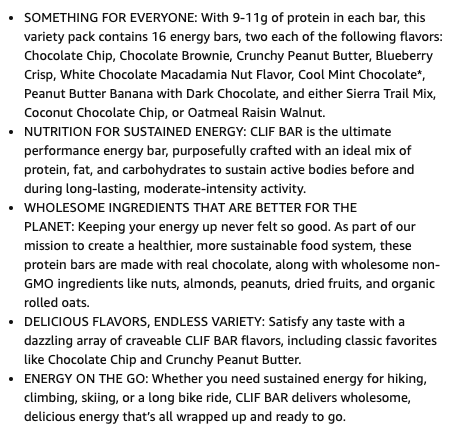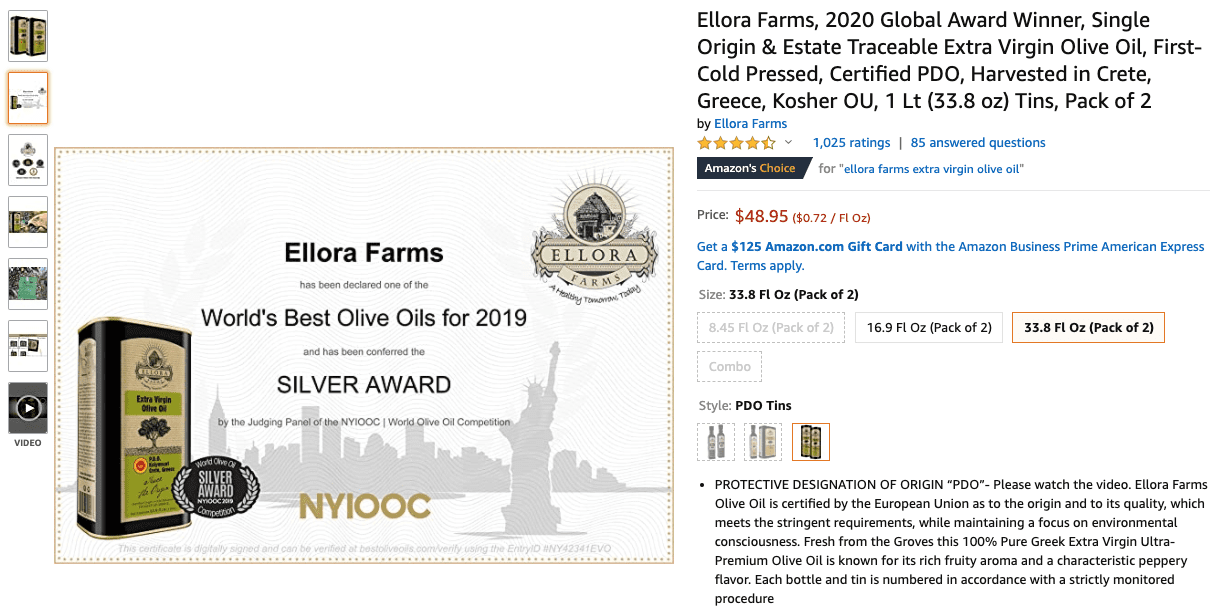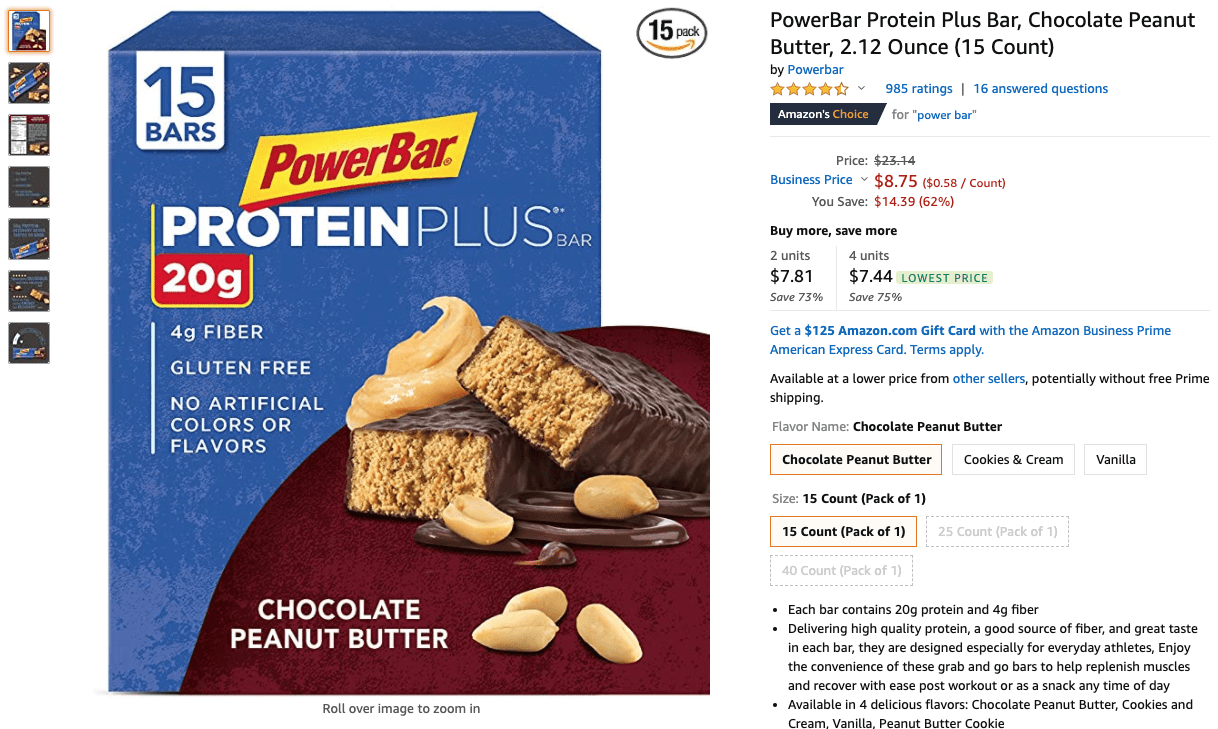Creating eCommerce Content That Sells

July 28, 2020

eCommerce item content can make or break your brand. It’s also one of the easiest things to get wrong. If you’re new to the eCommerce space or are looking for ways to drive more sales on your current business, start with these seven proven content tips to get the best results.
1. Go Beyond Your Label
Too often, brands try to replicate the packaging experience online. They transfer ingredients, weights, sizes, and regulatory information verbatim from the label into their product listing. While this information is important, it isn’t what’s going to differentiate your brand from the sea of competition. With literally millions of sellers competing in the big marketplaces (Amazon and Walmart), showing how you're different is priority #1!
Start by asking yourself these questions:
-
WHAT’S truly special about your design or features? Is your difference that you're the "tried and true" brand in a sea of knockoffs? Make sure that people know! Is it that you're the only farm-to-table vitamin available online? Compare your brand's story to the top performing brands in each marketplace to ensure that your assumptions about uniqueness hold true and then make sure that these differences are expressed in a way that's easily understood (and that fits your SEO insights). Use every element of your listing - the title, the images, the enhanced content, video, ads, etc., to reinforce your uniqueness.
-
HOW will these attributes improve life for your shopper? The point of difference is meaningless unless you create emotion in the shopper. Tell the shopper what will happen when they use their product— “You’ll forget that you’re eating kelp.” ... Then tell them how they'll feel afterwards: "You'll feel better about your diet and about yourself!"
-
WHO are you as a brand and why should the shopper care? Were the recipes for your "Nonna's Classics" sauce passed down from your great-grandmother? Did you think up the idea for your new "Peak Peanut" granola bar while on a hiking expedition with your family? Story matters, especially in crowded marketplaces that are often filled with generic category content.
2. Win the Whole Listing
To start, remember that you need to drive sessions as well as conversion - your 300 words of killer copy won’t be seen if you don’t first earn the click. Conversion can be influenced by just about anything, but sessions (visits) are influenced by what the shopper sees in their search results. That typically includes the main product image, the product title, and the price. Make sure that these three elements work together to create enough of a “hook” to draw the shopper in. If you can’t win the click, nothing else matters.
Your next priority should be “above the fold” content, or content that your shopper will see before they scroll down the page. Make sure to customize this content for mobile and desktop shoppers. It should allow the shopper to answer the question: “is this right for me?”
If the shopper does scroll down the page, your item has probably made it to the consideration round. At this point, you need to close the deal by reinforcing your key differentiators in an appealing way. This is where enhanced content (known A+ on Amazon) comes into play. Is the fact that you’re a gluten-free shortbread cookie a key differentiator? If so, don’t be afraid to repeat it here with a clear & recognizable image.
Finally, choose every word wisely - stay away from points that aren’t true priorities. Your job isn’t to give the shopper every piece of data about the product, but rather to give them the right information and inspiration to buy.
3. Craft Clear, Scannable, Benefit-Driven Copy
There are more compelling ways to communicate things like nutritional value and premium ingredients than transcribing them from the label. Creating benefit-driven copy allows you to touch on key differentiators within the context of your shoppers' needs and aspirations. Help shoppers connect the dots between item specs and how they will impact their lives. As an example, consider Clif Bar’s Amazon listing description below:

Along with being benefit-driven, this description is also clear and “scannable.” In other words, shoppers can quickly glance at the copy and identify key selling points. By using bullet points, caps, and other scannable text formats, you can draw attention to key differentiators without sacrificing simplicity. Don’t forget to consider order. The best listings will declare the benefit ("Nutrition for Sustained Energy"), explain how it’s delivered, and then circle back and reinforce the benefit in a different way ("Energy on the Go").
4. Do More with Images
Boring brands show images of their item’s packaging. Exciting brands tell a story through their images and aren’t afraid to experiment with different visual approaches.
To transform your photos into stories, include high-quality images of the ingredients or materials used to make your item. If the people who make your item or the locations from which ingredients are sourced are important to your product, include visuals to show the shopper. Don’t be afraid to show images of your product being used but be careful with "lifestyle imagery." When used properly, it can provide great context and enhance your equity - when it isn't, it can dull your message.
Retailers often have strict requirements for the main product image (for example, they may require images with a white background), but don’t let those requirements limit your creativity when it comes to the rest of your images. Using a variety of graphical approaches (while staying on brand) can make your listing more compelling and help tell your brand’s story. For example, superimposing relevant text onto an ingredient image can help lend context to the picture. Remember that there are different types of learners (some who like to read, and others who are more visually-oriented) and make an effort to appeal to both groups.
Images don’t have to be about the product specs and ingredients. Need an infographic to show how your heartburn medicine neutralizes acid? Throw it in there! Want shoppers to know that your olive oil won awards at the "World's Best Olive Oils" competition? Show, don't tell as Ellora Farms did!

Finally, make sure that your chosen hero image is mobile-friendly. Some brands are taking this to new levels by editing their packaging image to highlight key elements (removing copy that won’t earn the click or close the deal). In the examples below, Power Bar is going big and bold with enlarged ingredient visuals and bar count in this example:

5. Be Smart with Product Titles
It’s easy to get hyper-focused on your listing page content and forget about how important the title is. For years, brands have treated titles as repositories for SEO terms and overloaded them in an effort to earn higher SEO rankings. Don’t be tempted by this approach — it doesn’t work like it used to. While it’s important to consider the SEO value of your title, it should also be something that’s easily read and understood by a human audience (remember that you have to earn that click!).
Creating good titles is more of a science than an art. It requires discipline and a thorough understanding of your category. Rather than trying to get too creative, build a title structure that fits with category norms and allows shoppers to quickly sort through your offerings. Key title attributes usually include:
-
Your brand name
-
The item category (SEO term)
-
Flavor, color, or scent
-
Size
-
Count
Before deciding how to name your category or flavor, do some SEO research to determine what words are driving traffic to your competitors’ listings. You can also look at product reviews and questions to understand how customers are talking about a category and what words they’re using. Finally, your retailer may have rules that specify how your title can be structured and length - make sure you've reviewed these.
Once you decide on your title convention, make sure that all the listings you create follow suit. This consistency will make it easier for shoppers to compare items and sizing options (in search results or on your brand store) to find exactly what they’re looking for. It will also make it easier for you to maintain content for your growing eCommerce portfolio.
6. Drive Consistency Across Listings
In addition to using title conventions, it’s important to keep your content and copy format consistent across all of your listings. Shoppers will probably look at two or three of your items before making a purchase. If each of your listings uses a different content approach, then you’re forcing the shopper to do extra work to compare options.
Creating a content template to use during the drafting process is a great way to guarantee that you don’t deviate from your ideal structure over time. It will also help you be more deliberate in evolving your approach. In the template, lay out guidelines for what each bullet point should cover. For example, bullet number one could always talk about flavor, bullet number two could speak to your special ingredients, bullet number three could speak to the health benefits of those ingredients, and so on. If you decide to make changes to your template over time, make sure to update older listings.
7. Test, Listen, and Optimize
In the words of the famous Enlightenment writer Voltaire, “the best is the enemy of the good.” Don’t let your fear of making a mistake paralyze you — speed and efficiency are critical in eCommerce. Launch your listing, learn from in-market results, and continue to fine-tune your way to greatness as you learn more.
Sales results are one way to gauge if your listing is successful, but they’re not the only way to learn. Consider A/B testing as a more precise way to optimize your listing approach. One by one, you can test and compare the performance of different visuals, copy, and even SEO strategies. When done correctly, this approach can be a true competitive advantage. If it earns you a fraction of a percent improvement each month, you’ll be well on your way to massive future sales!
As you look for areas of improvement, don’t forget to pay attention to shopper feedback. Read product reviews and questions and revise your approach based on that insight. Over time, your listing should become a “conversation” between your brand and shoppers.
Make sure you have an efficient way to get notified of shopper feedback and responding in a timely manner. Believe it or not, your responses to shopper concerns and questions (which can be displayed on your listings) are an important part of your brand’s content.
The Bottom Line
The more time you spend creating eCommerce content and reviewing your competitors’ content, the more insight you’ll have into what works and what doesn’t. What seems difficult today will soon become intuitive. Don’t be afraid to experiment and build on your lessons learned.
Want to discuss how to take your content further on Walmart.com, Amazon.com, Instacart, or your own DTC store? Let us know - we'd be happy to offer a free consultation!
Ready to transform your strategy on Amazon?
Download BOLD's Services One Sheet.